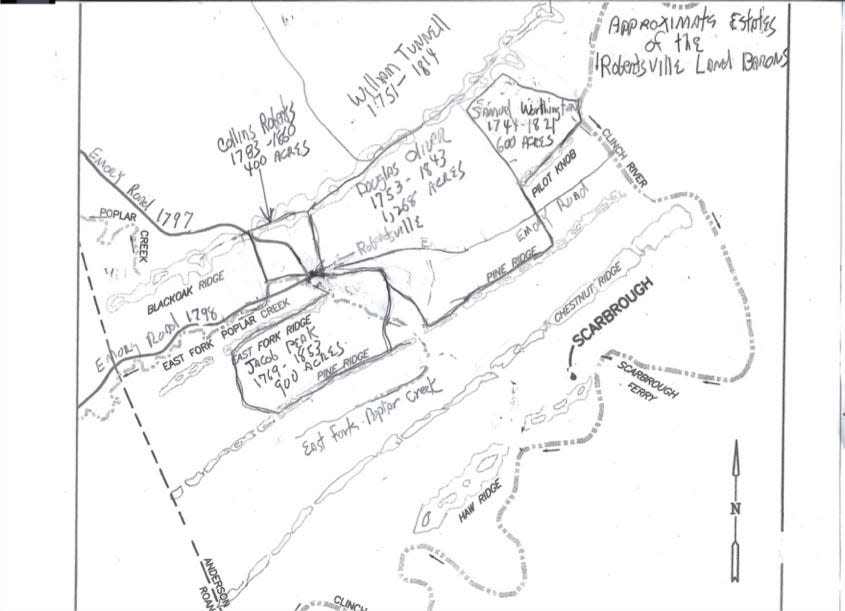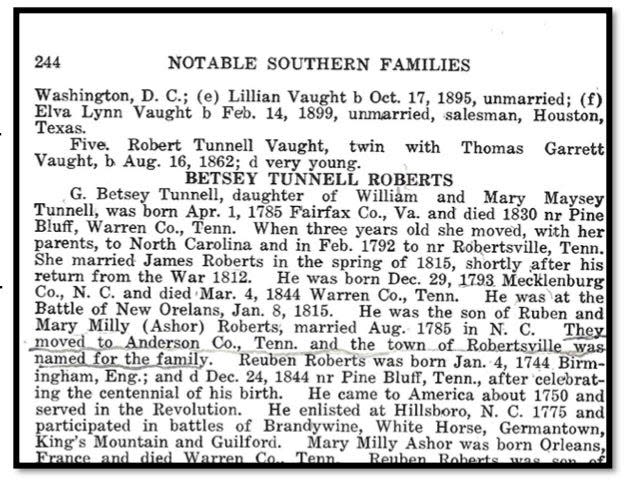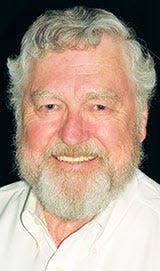Early history of Robertsville: 1800-1849

Continuing Dennis Eggert’s history of early Robertsville. This is the second in a series of four columns featuring his in-depth research into the bygone era well before Oak Ridge. In today’s column, Dennis reveals it was the Reuben Roberts family that the town of Robertsville got its name. As Robertsville grew, and the Emery Road brought travelers, changes, such as expansion to include other small communities and needed postal service developed.
***
More families began putting down their roots in this valley between the Black Oak and Pine Ridges. Among those families was the Reuben Roberts clan who had left North Carolina and settled here in 1804. Roberts, a North Carolina Revolutionary War veteran, settled here to start a new life on the frontier. A few years after his arrival, his son James married Betsy Tunnell.
As previously mentioned, the Tunnells were descendants of both French and English aristocracy and within the Tunnell family history documented in “Notable Southern Families,” it was Reuben Roberts whom the community of Robertsville was named after. However, by the 1820s, the entire Reuben Roberts family left this area settling in Warren County in Middle Tennessee.
In 1809, another historical icon had settled in this community. Collins Roberts immediately established himself as a successful local merchant and continued to expand his wealth by farming. His marriage to Sarah Gallaher in 1813, also helped promote his status within the community.

Sarah was from an influential family that settled in the Wheat Community. Collins Roberts was certainly one of the more colorful and controversial individuals who lived here. As we will see, he often had a tumultuous relationship not only with his wife, but also with some of his neighbors.
By the early decades of the 1800s, Robertsville became a self-sufficient community. It certainly benefitted from the nearby available resources. There were four mills in the adjacent Scarbrough community. As a grad student, Charles Seebers in his 1929 thesis for the University of Tennessee History Department identified a grist mill, flour mill, sawmill, and a cording machine owned by the Scarbrough family.
To the west of Robertsville, there was a salt well located in Winters Gap (now Oliver Springs) that provided salt to the community. In addition to being self-sufficient, Robertsville was also becoming a prosperous community.
Throughout the 1830s, the landed elite had realized their massive estates. Jacob Peak, Douglas Oliver, and Collins Roberts became the wealthiest citizens in the community. By this time, Samuel Worthington had died, and his 600-acre estate had been subdivided.
Douglas Oliver’s original purchase of 140 acres in 1803 would expand to 1,268 acres. Just before his death in 1843, he owned land from the top of Black Oak Ridge to Pine Ridge.

In addition to farming, Douglas owned one of the largest, if not the largest, legal moonshine stills in the county. The spring that fed his still is the same spring that feeds the huge municipal swimming pool today. Upon his death in 1843, one creditor owed his estate for 50 gallons of moonshine.
After Douglas’ death, his estate was subdivided into five sections; four were sold and one section retained by the family. Only daughter Amelia continued to live on a parcel that was once Douglas’ vast estate.
In 1805, Jacob Peak made his first purchase of 50 acres along East Fork Poplar Creek. Like Douglas Oliver, he continually expanded his land over time. At the time of his death in 1853, Jacob Peak owned 900 acres located in Gamble Valley and a portion of what today is downtown Oak Ridge.
After Douglas Oliver died in 1843, Jacob bought his distillery equipment and supplies to start his own distillery operation. Jacob’s distillery was located at a spring at the foot of the hill of where the Peak Cemetery is located today. Jacob Peak is buried here in the Peak Cemetery; however, there is no grave marker to identify his exact interment.
The most recognized citizen of historic Robertsville that many Oak Ridgers may have heard of was Collins Roberts. Although Collins Roberts may not have been the original founding patriarch, he was certainly an influential citizen who also may have played a role in naming this community.
To create a named community in the old days, a person of influence would apply to have a post office, and of course, naming it would be up to the discretion of the applicant. That is what Collins Roberts did. Using his clout, the “Robertsville” post office was created in 1832. It certainly helped his mercantile trade to have the post office in his store! Clark Crozier, Collins’ son-in-law, was the first postmaster. As the years passed, the Robertsville postal area grew and grew incorporating Elza, Lupton Crossroads, and even Scarbrough.
Collins Roberts was both a merchant and a farmer whom, over the years, amassed a fortune. As a merchant, many of his neighbors bought from him on credit. A list of notes carried by Collins Roberts from 1849 to 1852 revealed that he was owed approximately $17,600 from his customers. Today that would be $670,000!
It’s apparent that he sometimes had turbulent relationships with those around him. From Anderson County court documents involving nonpayment of credit, Collins often foreclosed on his non-paying customers.
An incident occurred in 1841, when Isaac Freels, feeling previously cheated by Collins Roberts, decided to take the matter into his own hands and recover the money he thought Collins stole from him.
Late one April night, after Collins returned home from Clinton, Isaac Freels, along with brothers Edward, William and a band of recruited confederates lay siege to the Roberts homestead. About 10 p.m., wife Sarah, daughter Abiah, guest Eliza Qualls, and two Negro boys heard a commotion outside.
Looking out the window they saw the nearby fodder stack on fire illuminating the entire area. Then, this unruly mob began shooting, throwing rocks, and banging sticks against the house demanding everyone come out. Sarah immediately dispatched the two Negro boys to nearby neighbors to summon help.
As wife Sarah, daughter Abiah, and guest Eliza Qualls stood resolutely by the fastened door, Collins Roberts barricaded himself at the back of the room with a firearm vowing to “defend his money or die by it”! Court records indicated that he claimed he had $10,000.
The situation became tense when the ladies saw hands slip under the front door in an attempt to lift the door off its hinges in order to make entry. Thankfully the McCamy and Kilpatrick neighbors arrived, and the assailants made a hasty retreat.
***
Thanks Dennis, for continuing the saga of early Robertsville. Collins Roberts featured prominently in the development of Robertsville but was not the founder or namesake. The third column in this series will bring us to the Civil War in Anderson County and also enlighten us on the schools in the area.
This article originally appeared on Oakridger: Early history of Robertsville: 1800-1849

